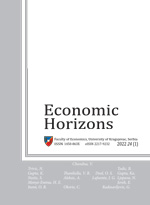ECONOMIC GROWTH AND THE INSTITUTIONAL TRANSITION OF THE REPUBLIC OF SERBIA
Edvard Jakopin
Ministry of Economy, The Republic of Serbia
Are the transitional countries of SEE trapped in institutional transition or not? The institutional transition that has been lasting for almost three decades, and almost two decades in the Republic of Serbia, initiated the rapid destruction of the institutions of the previous political and economic system, but the construction of new market institutions has been slow, inefficient and partial. The Republic of Serbia lost the three decades of economic growth and development, which, as evidenced by economic law, takes twice as much time to restore the system to the previous equilibrium of the length of the time which the system is located in off-balance. The average 3% growth in the seventeen transition years is insufficient to compensate for the enormous backlog of the 1990s. The contribution of the research study to the work focuses on the analysis of the interdependence of economic growth and institution building. A special viewpoint is aimed at the corruption factor destroying institutions in all transition countries, reducing their economic growth and productivity, and negatively affecting the attractiveness of FDIs.
Keywords: gender equality, gender segregation, vertical segregation, horizontal segregation, higher education, the Republic of Serbia
JEL Classification: O11, O43




